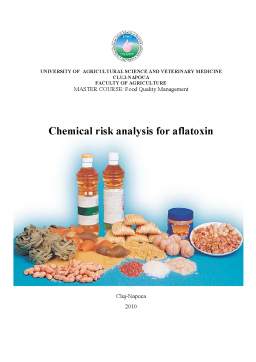Cuprins
- I. Chemical risk assessment 1
- 1.What are aflatoxins? 2
- 2. Physical and chemical properties 3
- 3. Hazard identification 7
- 3.1. Factors favorizing aflatoxin production 7
- 3.2. Occurrence 7
- 4. Hazard characterization 9
- 4.1. Toxicity 9
- 4.2. Stability in foods 10
- 4.3. Reccomended levels for aflatoxins presents in food 11
- 5. Effects on health 12
- 5.1. Aflatoxins and animal health 12
- 5.2. Aflatoxins and human health 15
- II. Risk management 17
- III. Risk communication 19
- IV. Chemical control 20
- 1. Methods of analysis for aflatoxins in foods and feeds 20
- 2. Monitoring techniques for assessing human exposure to aflatoxins 21
- 3. Control and management of aflatoxins 21
- 4. Measures to prevent contamination with aflatoxins 22
Extras din proiect
I. Chemical risk assessment
1. What are aflatoxins?
Aflatoxins are toxic metabolites produced by certain fungi in/on foods and feeds. They are probably the best known and most intensively researched mycotoxins in the world. Aflatoxins have been associated with various diseases, such as aflatoxicosis, in livestock, domestic animals and humans throughout the world. The occurence of aflatoxins is influenced by certain environmental factors; hence the extent of contamination will vary with geographic location, agricultural and agronomic practices, and the susceptibility of commodities to fungal invasion during preharvest, storage, and/or processing periods. Aflatoxins have received greater attention than any other mycotoxins because of their demonstrated potent carcinogenic effect in susceptible laboratory animals and their acute toxicological effects in humans. As it is realized that absolute safety is never achieved, many countries have attempted to limit exposure to aflatoxins by imposing regulatory limits on commodities intended for use as food and feed.
In the 1960 more than 100,000 young turkeys on poultry farms in England died in the course of a few months from an apparently new disease that was termed "Turkey X disease" It was soon found that the difficulty was not limited to turkeys Ducklings and young pheasants were also affected and heavy mortality was experienced A careful survey of the early outbreaks showed that they were all associated with feeds, namely Brazilian peanut meal An intensive investigation of the suspect peanut meal was undertaken and it was quickly found that this peanut meal was highly toxic to poultry and ducklings with symptoms typical of Turkey X disease. Speculations made during 1960 regarding the nature of the toxin suggested that it might be of fungal origin. In fact, the toxin-producing fungus was identified as Aspergillus flavus (1961) and the toxin was given the name Aflatoxin by virtue of its origin (A.flavis--> Afla). aflatoxins are produced primarily by some strains of A. Flavus and by most, if not all, strains of A. parasiticus , plus related species, A. nomius and A. niger
Aspergillus flavus seen under an electron microscope.
This discovery has led to a growing awareness of the potential hazards of these substances as contaminants of food and feed causing illness and even death in humans and other mammals.
The aflatoxins consist of about 20 similar compounds belonging to a group called the difuranocoumarins, but only four are naturally found in foods. These are aflatoxins B1 , B2, G1 and G2 plus two additional metabolic products, M1 and M2, that are of significance as direct contaminants of foods and feeds. The aflatoxins M1 and M2 were first isolated from milk of lactating animals fed aflatoxin preparations; hence, the M designation. Whereas the B designation of aflatoxins B1 and B2 resulted from the exhibition of blue fluorescence under UV-light, while the G designation refers to the yellow-green fluorescence of the relevant structures under UV-light. These toxins have closely similar structures and form a unique group of highly oxygenated, naturally occuring heterocyclic compounds. Aflatoxins B2 and G2 were established as the dihydroxy derivatives of B1 and G1, respectively. Whereas, aflatoxin M1 is 4-hydroxy aflatoxin B1 and aflatoxin M2 is 4-dihydroxy aflatoxin B2.
2. Physical and chemical properties
Aflatoxins are potent toxic, carcinogenic, mutagenic, immunosuppressive agents, produced as secondary metabolites by the fungus Aspergillus flavus and A. parasiticus on variety of food products. Aflatoxin B1 (AFB1) is normally predominant in amount in cultures as well as in food products. Pure AFB1 is pale-white to yellow crystalline, odorless solid. Aflatoxins are soluble in methanol, chloroform, actone, acetonitrile. A. flavus typically produces AFB1 and AFB2, where as A. parasiticus produce AFG1 and AFG2 as well as AFB1 and AFB2. Four other aflatoxins M1, M2, B2A, G2A which may be produced in minor amounts were subsequently isolated from cultures of A. flavus and A. parasiticus. A number of closely related compounds namely aflatoxin GM1, parasiticol and aflatoxicol are also produced by A. flavus. Aflatoxin M1and M2 are major metabolites of aflatoxin B1 and B2 respectively, found in milk of animals that have consumed feed contaminated with aflatoxins.
Aflatoxins are normally refers to the group of difuranocoumarins and classified in two broad groups according to their chemical structure; the difurocoumarocyclopentenone series (AFB1, AFB2, AFB2A, AFM1, AFM2, AFM2A and aflatoxicol) and the difurocoumarolactone series (AFG1, AFG2, AFG2A, AFGM1, AFGM2, AFGM2A and AFB3). The aflatoxins display potency of toxicity, carcinogenicity, mutagenicity in the order of AFB1 > AFG1 > AFB2 > AFG2 as illustrated by their LD50 values for day-old ducklings. Structurally the dihydrofuran moiety, containing double bond, and the constituents liked to the coumarin moiety are of importance in producing biological effects. The aflatoxins fluoresce strongly in ultraviolet light (ca. 365 nm); B1 and B2 produce a blue fluorescence where as G1 and G2 produce green fluorescence.
Preview document
Conținut arhivă zip
- Chemical Risk Analysis for Aflatoxin.doc



























